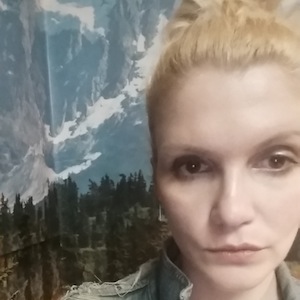
Part I
(Cambrian - Ordovician)
(1)
This feral shape:

- (a) laid smooth and invisible in the darkness, unexplored
- (b) fanned out beneath the midnight zone
- (c) stretched out in the lightless sea, a bald abyssal plain
- (d) tipped towards the trenches, tipped towards the trembling core
- (e) all of the above
(2)
Here, the seabed:

- (a) sent up a cloud of pale silt as the body sank then
settled, the sperm whale mostly eaten - (b) cradled bones where golden mussels clung, violet limpets
sprung, like a drowned pharaoh studded with precious stones - (c) contained a dark tickled
by the mouths of brittle stars - (d) blanketed the blackened mantle,
cyclically bodies reduced to sand - (e) all of the above
(3)
The following image illustrates:

- (a) we foster pity for bodies forgotten in the dark
- (b) we forget some bodies are built for dark
- (c) we feel about blindly for that which is lost
- (d) we predict upheaval on the black horizon
- (e) all of the above
×
Part II
(Un)earthing
(1)
The glaciers calve in spring: 12,000 icebergs sent out. More and faster than before. Extra-large, large, medium, and small. Through ice fields and silver foam. Seeking. Then docking like ghostly teeth with colossal roots, driven down into the black jaw of the sea. The tourists flock to Ferryland to photograph the pinnacles parked offshore. Send up the drones! Like seabirds circling—the white molar seen from above. Holy Grail hunters suspend their search (it was a long shot anyway) to ogle from the roadside. Kayakers row out to chip off shards, sip cocktails in the rocking wake. Scientists release their microphones on long waterproof wires, to record the gossip and groan. Divers drop from zodiacs and descend, reach out to pet the blue underbelly with gloved hands. The attraction melts in the summer sun, slowly but faster than before. Down to bergy bits and growlers. The crowds disperse. The water rises. Soon we’ll need to get out the ropes and drag our houses up the hillside.
Knowing what you know, what do you think the icebergs were gossiping about?
- (a) prehistoric pathogens being reintroduced into the sea
- (b) the absurdity of tourists photographing the optical illusion of an iceberg held in one hand
- (c) the terror of diminishing
- (d) the terror of subsuming
- (e) all of the above
(2)
At the museum, we learned the settlement would fail. Their hearth their shoes their spoons would sink into the meadow. Their coins their rings their hammers waited. Waited and waited. For retired businessmen, for metal detectors. Then when the tingling began they cried out: here here here.
Unearthed, the objects spoke: Vikings shuttled between the shores with their long boats with their long oars with their blood-striped sails. Their teeth were brushed and their hair was clean. They carried women draped in seal skins. They carried weeping slaves. They carried squash and salted goat. In a muffled trance they rowed. Orcas squealed beneath the bow, then cut the surface in black arcs. Auroras ribboned through the dark. The Vikings grew hot at noon, then cold at dusk, nesting en masse in the middle of the boat. Hands many hands. After seven days the frisson of shoreline, the rapture of plunging gannets. Entering Medusa’s Cove they slowed. There the water became shallower and clear. Jellyfish bloomed in spring. With lions’ manes with fervent orange with pellucid bells they softly propelled, like drowned saints wearing tattered veils.
The author conveys this story in order to:
- (a) she does not know why, but is fine with it
- (b) she does not know why, and feels shame
- (c) she does not know why, and is crippled with doubt
- (d) she does not know why, it is your job to know why
- (e) all of the above
(3)
The guidebook recommended the view: where hill drops to cliff and narrows open out to ocean. We had been told the black clouds of capelin were surging from the south and the whales were nosing up behind. It was possible to see the feeding, leaping pods. The view! You must see the view! When we arrived the fog had rolled in, at the cliff’s edge we encountered a bank of white. The view obscured: no ocean no black water no dorsal fins no ships no port.
Now near this hill there was a smaller hill, where criminals had once been dipped in hot tar, wrapped in chains, and suspended for public viewing. After a while, the townspeople would lower the bodies, seal them in barrels, and roll them down the hill to land in Dead Man’s Pond, with splash then sink. In the winter the water would freeze and the children would skate across the surface and the ghosts would pummel the ice from below. In 1869, two girls fell through and drowned amongst the barrels and their rescuer did the same. Now bedraggled spirits wander the banks, through marsh grass and pitcher plants. And sometimes a spectral dog bounds across the heath. And sometimes a headless pirate crawls on all fours, feeling out for gold dubloons. And sometimes the Titanic’s mayday crackles from the south, up and over the hyper-oceanic barrens.
Knowing what you know, how might this story end?
- (a) when we held out our hands they disappeared
- (b) we considered returning to the rental car
- (c) we encountered a bank of white
- (d) we encountered the blankness of our future, this feral shape
- (e) all of the above
×
Part III
Marguerite (in fractions)
Closely read this passage, and then answer the questions that follow.
In 1541, Marguerite sailed out on Roberval’s ship, from a French port bound for the New World. Roberval was either Maguerite’s uncle, or brother, or cousin. Regardless, she was young and she blushed easily and he could not have her. On the journey, she became enamored with a young man, who shall remain nameless, who may or may not have been an aristocrat. When Roberval discovered what they had been doing, down in the hull between the barrels of wine (hands many hands), he tossed the man and Marguerite and Marguerite’s maid into the shallows, offshore the Isle of Demons. Marooned! On the island there were the prehistoric ghosts of giant bears, spectral wolves, and tortoises carved from sea mist. The man died quickly, followed by the maid, of what it is not known, and they may or may not have been eaten by Marguerite for Marguerite was pregnant and ready to eat anything. The baby was born. Marguerite pulled it out with her own hands in a contorted position and cleaned its face with leaves. The baby quickly died from lack of milk, and Marguerite crawled into a cave and shivered for several days. Then she learned to bludgeon seals basking on the beach and to steal eggs from the Great Auks’ nests and many other things. She became an apex predator. For two years she was able to survive until some fisherman appeared and brought her home. She became a schoolteacher and grew old and then died, somewhere and in some way.
There is a fishing village on the isle now (lobster, halibut, turbot, crabs, cod) and the cave is a tourist attraction, though no one visits.
(1)
The following convergent lines illustrate:

- (a) transgression
- (b) subduction
- (c) she was smooth and invisible in the darkness,
unexplored - (d) where my hands came into being, like
animals we crossed the plain - (e) all of the above
(2)
Interpret the following plotted points:

- (a) hands many hands
- (b) woman weeping
- (c) ash cloud
- (d) black mantle over white shoulders
- (e) all of the above
(3)
The rate at which Marguerite devolved to animal:

- (a) I am less
- (b) I am lesser
- (c) I am least
- (d) I am none
- (e) none of the above
For more information about this piece, see this issue's legend.

Beth Steidle is a writer, illustrator, and book designer living in Brooklyn, NY. Her work has appeared in Fairy Tale Review, Drunken Boat, and DIAGRAM, amongst others. In 2014, she received a poetry fellowship from the New York Foundation for the Arts and her first book, The Static Herd, was published by Calamari Press.
7.1614° N, 134.3766° E
Here is a 12,000-year-old freshwater lake on a tiny island in Micronesia. Due to the isolated environment, the golden jellyfish there have lost their sting. They follow the sunlight across the surface of the lake and back again. You can swim there, out and further out, until you are surrounded.

